
Need Help In Choosing The Best Reimbursement Model For Your Practice?
Lets schedule a free 1:1 billing consultation with me right now!
“Reimbursement”.
It’s a fancy ten-dollar word for plain old payment.
But in healthcare, it means everything.
Reimbursement in the medical world translates into a provider or healthcare facility collecting payments from the big government programs like Medicare and Medicaid or from private insurance companies for the healthcare services provided.
The way it works is the hospitals, labs and other caregivers send a bill after treating patients. The insurance company or agency reviews the charges and pays a negotiated amount.
Without a steady flow of reimbursement checks, even the best hospitals and doctors would close up shop before long.
However…
In healthcare, there are many reimbursement models to know. As a doctor, understanding each is key to picking what fits you best.
Take Fee-For-Service Reimbursement, for example. With this model, you bill for each service you provide and get paid accordingly. It’s simple but may not fit if you want steady income. Capitation Reimbursement, on the other hand, pays you a set amount per patient no matter what. You get the same pay whether patients come in or not. This guarantees income but risks leaving you short if patients need a lot of care.
This article aims to outline the major healthcare reimbursement types so you can weigh the pros and cons for your practice. The goal is to help you pick a system that lets you earn a good living while also providing the best care.
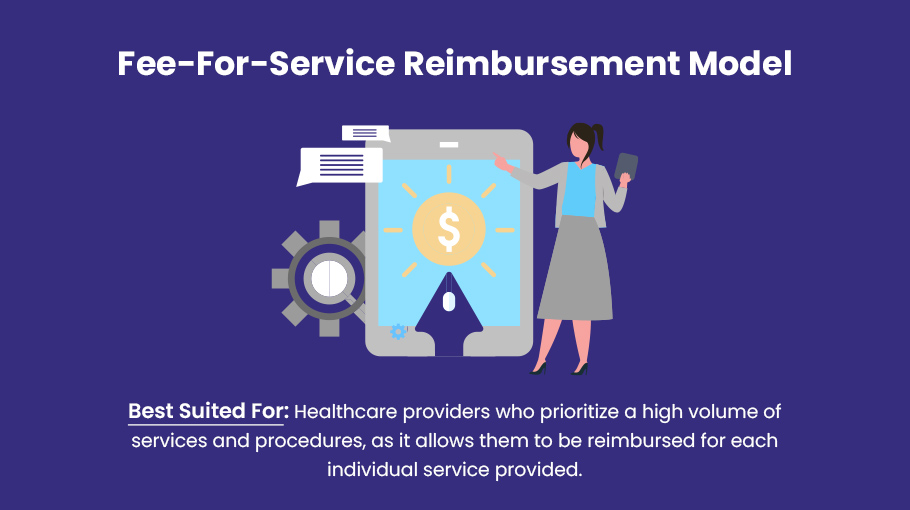
1). Fee-For-Service Reimbursement Model
Best Suited For: Healthcare providers who prioritize a high volume of services and procedures, as it allows them to be reimbursed for each individual service provided.
Fee-For-Service (FFS) is the traditional medical reimbursement model that pays doctors for each and every service they provide to the patient.
A patient walks in with a bum knee, that’s one fee. Doc orders an x-ray to see what’s the matter, that’s another fee. Gives some advice or a brace, another fee. It’s like a car mechanic – you pay for the parts and labor by each little thing.
The physician would then bill the insurance for the patient’s consult, the x-ray test, the exams, any medicines.
It’s a straightforward reimbursement model but could lead to over-testing and over-treating. Lots of volume but not always what was best for the patient. The more services a doctor provided, the more they’d make, even if it was more than medically necessary.
| PROS | CONS |
|---|---|
| ✔️ Full Access to Care: Patients can receive full access to care options they require if they can pay for the services. ✔️ Autonomy in Treatment: Patients have the freedom to choose their healthcare providers and the type of treatment they want. ✔️ Unlimited Choice: There is an unlimited choice of non-experimental treatments available. ✔️ Direct Compensation: Providers are directly compensated for each service they provide. ✔️ Straightforward Billing: The billing process is straightforward, making it easier for providers to get paid for services rendered. | ❌ Costly Healthcare: The FFS model is often blamed for spiraling healthcare costs. ❌ Incentive for More Services: There’s a risk of unnecessary medical procedures as providers are incentivized to offer more services to earn more money. ❌ Barriers to Quality Care: The model can create barriers to quality care and hinder care coordination. ❌ Complex Bills: Patients may receive long and confusing bills due to unbundled payments for each service. |
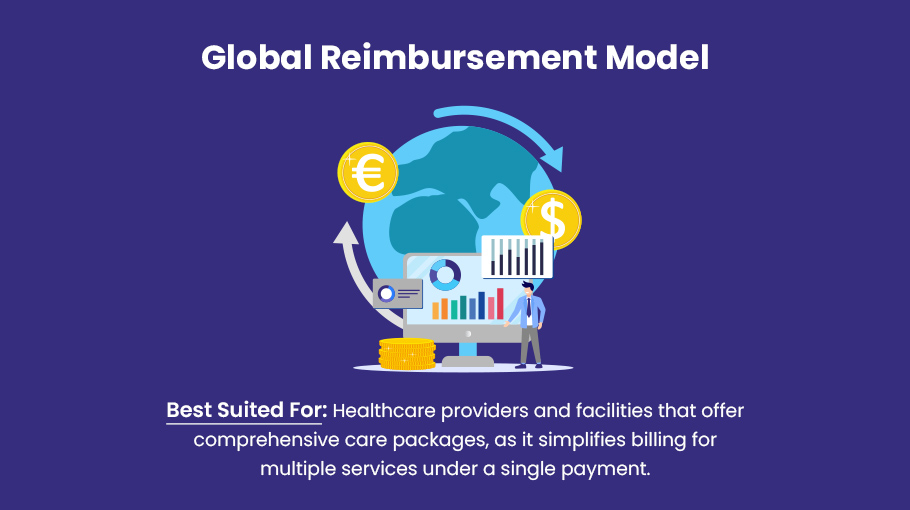
2). Global Reimbursement Model
Best Suited For: Healthcare providers and facilities that offer comprehensive care packages, as it simplifies billing for multiple services under a single payment.
Let me break it down for you plainly: “Global Reimbursement” model is when the doctor gets a single payout for a bunch of procedures, not a pile of payments for each one. It can be applied to services done in one sitting or stretched over some time frame.
Take knee surgery for example. That includes the initial visit, the surgery itself, follow ups for 6 months after – the whole treatment package. Here the doctor will bill the global bundled code, and get paid the global fee.
Here if the doctor tries to manipulate Medicare by billing the services all split up, despite getting paid for all those services in a single payout – the doctor’s practice might face “unbundling” charges in return.
| PROS | CONS |
|---|---|
| ✔️ Simplified Billing: Providers deal with a single, comprehensive bill for all services rendered during an episode of care. ✔️ Predictable Revenue: Providers can predict their revenue as they receive a predetermined amount for a patient’s care. ✔️ Encourages Efficiency: This model incentivizes providers to deliver care efficiently to stay within the budget. | ❌ Financial Risk: Providers assume more financial risk if the costs of services exceed the fixed payment. ❌ Potential for Reduced Care: There’s a risk of providers reducing the quality or quantity of care to stay within budget. ❌ Complexity in Implementation: It can be complex to implement due to the need to define the scope of services included in the global fee. |
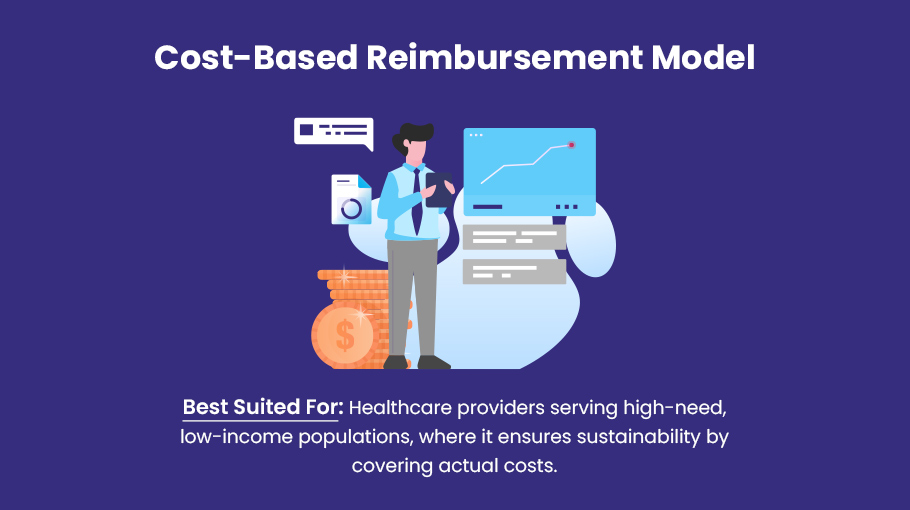
3). Cost-based Reimbursement Model
Best Suited For: Healthcare providers serving high-need, low-income populations, where it ensures sustainability by covering actual costs.
The Cost-based Reimbursement model is one way Medicaid pays certain providers based on their actual costs of caring for recipients. Rather than a set fee-for-service, providers submit their real expenses for caring for Medicaid patients. These expenses are audited and then used to determine payment.
*Note: Interestingly, not all services delivered are eligible for cost-based payment because it is limited to allowable costs that are directly related to the provision of healthcare services.
Say a rural health clinic spends $100,000 last year on nurses, supplies, and facilities to care for Medicaid patients. The clinic submits detailed cost reports to Medicaid showing the $100k in expenses. Medicaid audits these costs and determines they are justified. Since Medicaid wants to ensure continued access for low-income individuals in rural areas, they agree to reimburse the clinic $90K – enough to cover most of their actual costs for serving this vulnerable population. This cost-based payment gives the clinic the support it needs to keep its doors open and provide essential care.
| PROS | CONS |
|---|---|
| ✔️ Fair Compensation: Providers are reimbursed based on the actual costs of the services provided, ensuring fair compensation. ✔️ Coverage of Costs: It allows for the coverage of all costs incurred by the provider, including indirect expenses. | ❌ Complexity: The model can be complex due to the need to accurately account for all costs. ❌ Limited Incentive for Efficiency: There is less incentive for providers to be cost-efficient since reimbursement is based on costs incurred. |
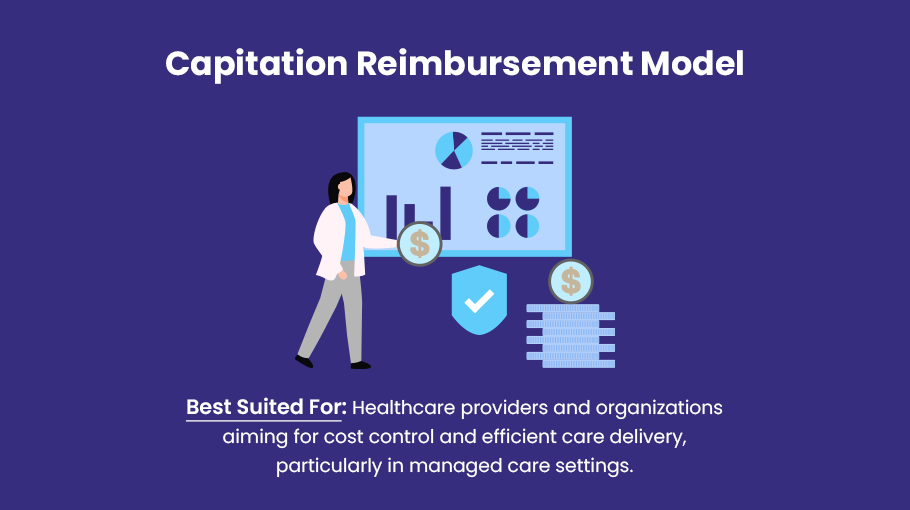
4). Capitation Reimbursement Model
Best Suited For: Healthcare providers and organizations aiming for cost control and efficient care delivery, particularly in managed care settings.
Some organizations that provide health care and certain other medical services receive a fixed payment amount each month for each person who has signed up to get care from them. These prepaid sums are called “Capitation Reimbursements”.
Typically, an insurance outfit will figure how much they will pay the provider every month. They review this number each year to make sure it’s still right. The idea is that people in these plans can see their doctors whenever they need to. At the same time, the doctors know they’ll get at least a minimum payment each month.
Another benefit is that medical costs are capped. In theory, this helps make sure they don’t go up faster than the economy.
For example, say an HMO gets $200 per month for each plan member. If the HMO has 5,000 members, they would get $1 million each month. The HMO would use this money to pay its doctors, clinics, and hospitals for the care provided to members. If costs of care go up, the HMO may ask the insurance company to increase the monthly capitation rate.
| PROS | CONS |
|---|---|
| ✔️ Efficiency and Cost-Control: Encourages providers to focus on preventive care and cost-effective treatment strategies. ✔️ Reduced Overhead: Simplifies billing and reduces bookkeeping overhead for providers. ✔️ Predictable Income: Offers providers a fixed amount per patient, making income predictable. | ❌ Potential for Under-Service: May lead providers to offer fewer services to stay within budget. ❌ Cheaper Services: Could incentivize the use of cheaper drugs or services. ❌ Population-Based Rates: High population areas might result in lower capitation rates, affecting income |
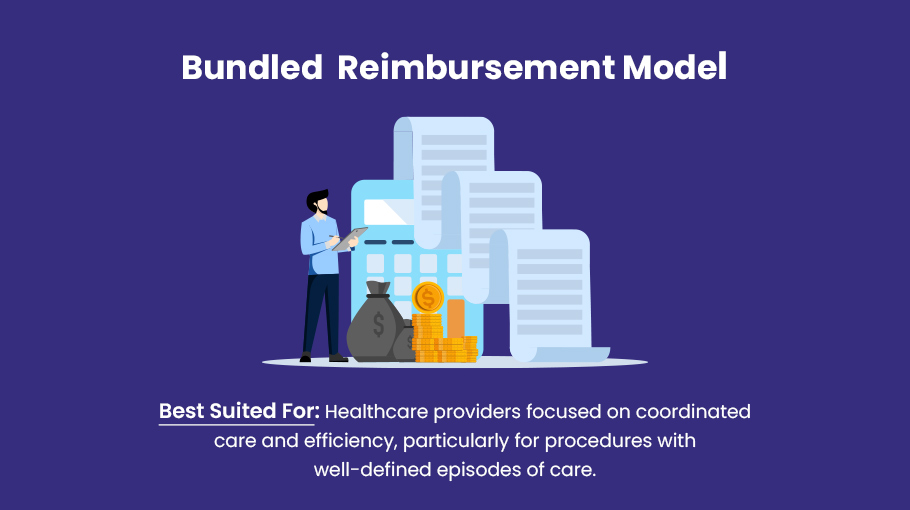
5). Bundled / Episode-Based Reimbursement Model
Best Suited For: Healthcare providers focused on coordinated care and efficiency, particularly for procedures with well-defined episodes of care.
The bundled reimbursement model is a bit of a hybrid between the fee-for-service and capitation reimbursement model.
This reimbursement methodology is a sort of middle ground between paying fee-for-service, where providers get paid for each little thing they do, and capitation, where they get one lump sum per patient no matter what. With bundled payments, they get a single payment to cover a whole episode of care.
So for a knee replacement, the hospital, surgeons, and physical therapists would split up one bundle for that operation and all the associated care.
For example, say a man named John needs a knee replacement. The hospital and doctors will get a single bundled payment to cover the surgery, hospital stay, physical therapy, and follow up care for the next 90 days. If John has complications or needs extra services, the providers have to eat those costs. But if John recovers quickly and doesn’t need as much care, the providers get to keep the difference. The incentive is for them to work as a team to give John excellent, efficient care.
It’s an interesting approach, getting these providers aligned and collaborating instead of working in silos. And it flips the incentives too – volume goes down, efficiency goes up.
| PROS | CONS |
|---|---|
| ✔️ Incentivizes Quality and Efficiency: Encourages providers to deliver high-quality, coordinated care within a budget. ✔️ Promotes Collaboration: Fosters collaboration among providers across different settings to improve care coordination. ✔️ Predictable Costs: Provides a single, comprehensive payment that covers all services in a patient’s episode of care, making costs predictable. | ❌ Complexity: Can be complex to implement due to the need to define the scope of services included in the bundle. ❌ Financial Risk: Providers may face financial risk if the costs exceed the bundled payment amount. ❌ Potential for Reduced Services: There’s a risk of reducing services to stay within the fixed payment, which could affect care quality |
Let BellMedEx help you choose the ideal reimbursement strategy for your practice!
If there’s one thing we know, it’s medical billing. Been in the business for years, getting docs paid for how they like it—by the patient, by the month, or by the bundle. Whatever payment plan suits your practice best, BellMedEx medical billing services company can set it up.
Our billing team has done it all—fee-for-service, capitation, cost-based, bundled, you name it. We know how to bill so you get paid, accurately and on schedule.
Need help with choosing the best reimbursement model for your practice?
Schedule a free medical billing consultation with us, so we can help you set up the ideal reimbursement strategy for your practice. And whether it’s fee for service, capitation, or bundled, our specialists know how to file so you get what you’re owed, fair and square.





